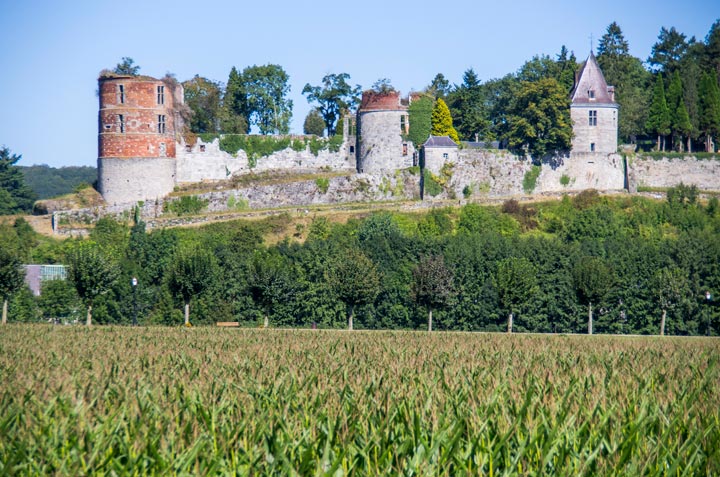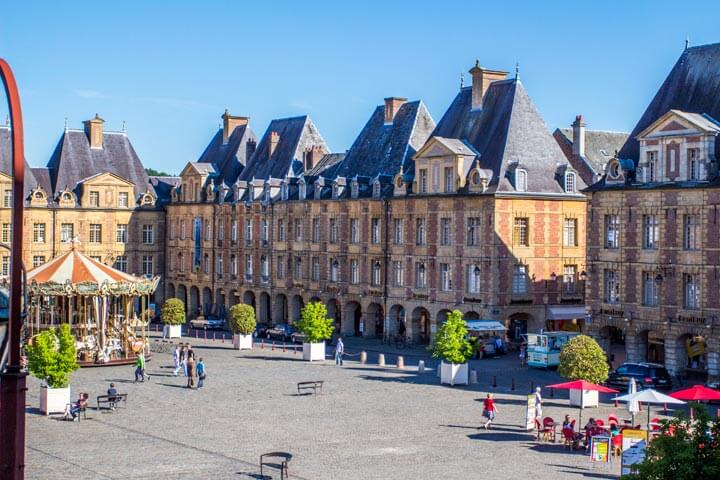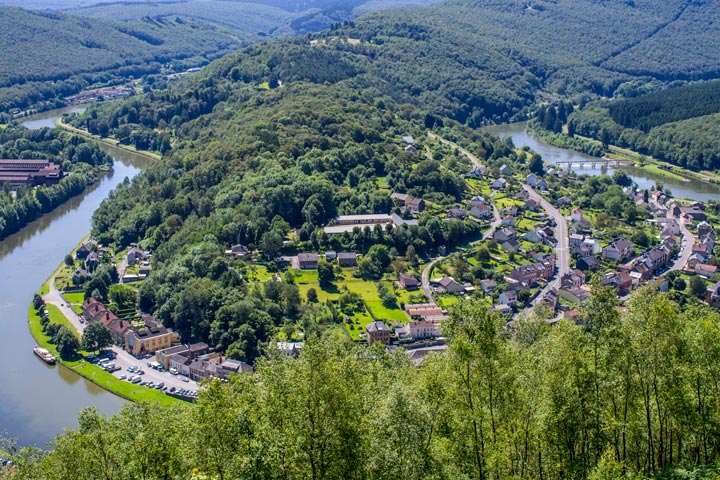Our towns and villages are not lacking in character
![]() = Towns and villages crossed by the Voie Verte Trans-Ardennes
= Towns and villages crossed by the Voie Verte Trans-Ardennes
Fumay
12 km away from Hargnies. This beautiful village is very marked by the exploitation of slate quarries which made its fortune in the 19th century. It is still known as "the city of slate", and these slate quarries are still very visible today. The fresco of the "Scailleuteux", which can be seen in the heart of Fumay, pays tribute to the work of these men who extracted and cut the blocks of slate.
Givet
20 km away. This pretty town on the Meuse River is dominated by the Fort of Charlemont, a fortress built by order of King Carlos V in 1555. There are also the remains of fortifications designed by French architect Vauban in the 18th century to keep it in the French domain when it became French. Charlemont, the citadel of Givet, is today classified as a historical monument.
The Pointe de Givet National Nature Reserve showcases the unique geology of our region. But it also contains 454 plant species and 320 animal species.

Hierges
13 km away. One of the most beautiful villages in the Ardennes, with a well-preserved medieval centre and a castle built in the 9th century.

Revin
22 km away. This commune stretches over 3 meanders of the Meuse. Dominated by the Mont Malgré-Tout, a hill that should become your nemesis if you are a cyclist, it still bears the scars of the metallurgical exploitation that was its main activity in the 19th century. It has also managed to preserve its medieval centre. You will see a very beautiful timber-framed house dating from the 16th century, which houses the museum of old Revin.
Monthermé
20 km away. Another beautiful village nestled in a meander of the Meuse, then spread out on the Semoy, an equally beautiful river. Monthermé is nicknamed "the pearl of the Ardennes". Together with the site of Roc-La-Tour, it offers one of the most beautiful views of the Ardennes. Evidence of a Magdalenian camp dating back some 15,000 years has been found here. Also worth seeing: The Saint-Rémy de Laval Dieu church, one of the oldest Premonstratensian abbeys, which can be visited in the high season. The viewpoints of La Roche à Sept Heures and La longue Roche offer a remarkable panorama over the valley and the Meuse loop.
Haybes
10 km away. Like Fumay, Haybes was an important slate mining centre until the first half of the 20th century, with about fifty slate quarries. The colours of the slate roofs, with their pink reflections, earned it the nickname "Haybes-la-Rose" or "Haybes-la-jolie" (Haybes-the-lovely-one).
Vireux-Molhain
10 km away. Between Fumay and Givet, this very old village boasts not only the oldest Roman church in Christendom, but also a nature reserve that will delight geology and palaeontology enthusiasts. Indeed, the Collegiate Church of Saint-Ermel was founded in 752, as attested by its crypt of blue stone columns. As for the site of the Mur des douaniers, it presents an astonishing collection of creatures coming straight out from the Devonian period, including a profusion of trilobites. There are also fossils of corals and cnidarians. All of these fossils are found directly on the rocks, but beware of covetousness! The site is protected and it is forbidden to collect them. If you want to learn more about this extinct fauna, go to the Musée des minéraux, roches et fossiles des Ardennes in Bogny-sur-Meuse.
Rocroi
30 km away. In 1555, in response to King Carlos V's decision to build the fort of Charlemont in Givet, the French king Henry II ordered the fortification of Rocroi. The small town was built in a star shape, to enable the soldiers of the garrison to reach their post as quickly as possible, wherever they were. This architectural feature, which gave it its nickname of "star city", is rare, as it is shared only with Palma-Nova, a small Italian town. It was in Rocroi that the French Duke of Enghien won the Battle of Rocroi against the Spaniards, a decisive battle for France in the Thirty Years' War.
Charleville-Mézières
40 km away. The Ardennes capital, built on the Meuse, also has many remains of fortifications. But it is best known for its magnificent Place Ducale, which dates from the 17th century. This marvel owes its Parisian Place des Vosges appearance to the fact that it was designed by Clément Métezeau, the brother of Louis Métezeau, the architect of the latter. Charleville-Mézières is also the birthplace of the French poet Arthur Rimbaud. A beautiful museum, housed in an old mill built on the banks of the Meuse, is dedicated to him. A must-see! You can extend your visit by discovering the murals evoking the work of the Charleville-native poet all along the streets (possibility of a guided tour). The Val Reserve Wood, at the outskirts of the town, is the second largest nature reserve in the region. It boasts 225 plant species and over 130 animal species in its 14 hectares.

Sedan
50 km away. The Sedan castle, which proudly dominates the town, is the largest castle in Europe, with an impressive surface area of 35,000 m². Its construction began in the 15th century, during the Hundred Years' War. It has been enlarged over the centuries and has survived intact. It is the setting for many shows, including the Medieval Festival held every May. Tours suitable for children (themed activities such as Playmobil, Easter, Halloween) and escape games are also held there.
The Belgian Ardenne side Some key places to visit
Thanks to the location of Hargnies, in the very heart of the "finger of Givet", it will be very easy for you to discover some of the most emblematic sites of the Belgian Ardenne from our gîtes. Here is a small summary of the Belgian must-sees relatively close by.
Dinant
40km away. Another magnificent old town built on the Meuse! Dinant is set against a cliff, from which its famous Bayard rock stands out. It is also overlooked by a thousand-year-old citadel (built in 1051) which offers superb views, but it is probably the "bulb" of its collegiate church, Notre-Dame, which best symbolises it. It is also the city of Adolphe Sax, who invented the saxophone. Useful tip for beer lovers: the Abbey of Notre-Dame de Leffe, where you can discover how the famous eponymous beer is brewed, is located right next door.

Bouillon
43km away. Another ancient city built on the banks of the Semoy (oops! Here in Belgium, we write "Semois") dominated by the Castle of Bouillon, an imposing thousand-year-old fortress. Nearby is the Giant's Tomb, one of the most beautiful Walloon panoramas. It is classified as "exceptional heritage of Wallonia" and "natural heritage of landscape interest".
Chimay
44 km away. Another must-see destination for Trappist beer lovers! But not only that. Because the town of Chimay has other magic tricks to offer: its magnificent castle, the aquascope of Virelles, reputed to be "one of the most beautiful natural sites in Belgium". Not far away, Soulme, Fagnolle, Vierves-sur-Viroin and Lompret boast of being on the list of the most beautiful villages in Wallonia. Are you a fan of the French comic actor Dany Boon? Visit the filming locations of his movie "Rien à déclarer" ("Nothing to declare"), located in Macquenoise.
Rochefort
40 km away. A small town which hosts a Laughter Festival, where great comedians, including famous Belgian comedian Raymond Devos, have performed. It offers a wide range of things to see in the area: the Han caves Domain, which offers a visit to the beautiful caves and its animal park, 2 breweries, the Brasserie de la Lesse, but above all that of the abbey of Notre-Dame-de-Saint-Rémy de Rochefort, where one of the 10 Trappist beers is brewed, and the magnificent Lavaux-Sainte-Anne Castle, with its deer park.
Chassepierre
62 km away. Another beautiful little town, watered by the Semois, listed as one of the most beautiful Belgian villages. In summer, it becomes the scene of the International Street Arts Festival, the oldest festival of its kind in Europe.
Durbuy
80 km away. This pretty little town, bordered by the Ourthe, is nicknamed "the smallest town in the world", but paradoxically, its municipality is one of the largest in Belgium, with some forty villages and hamlets. Among them is Wéris, one of the most beautiful villages in Wallonia. The surrounding countryside is very popular with Belgians. The old town of Durbuy is also very attractive with its 17th and 18th century limestone houses topped with slate.
Namur
80 km away. It would be a mistake to miss the capital of the Walloon region, which also boasts a citadel, modified by the French architect Vauban, offering a magical view of the city. Namur also has beautiful streets where you can stroll to discover the rich monuments of its historic centre: the theatre, the belfry, the Walloon parliament and numerous private mansions.

